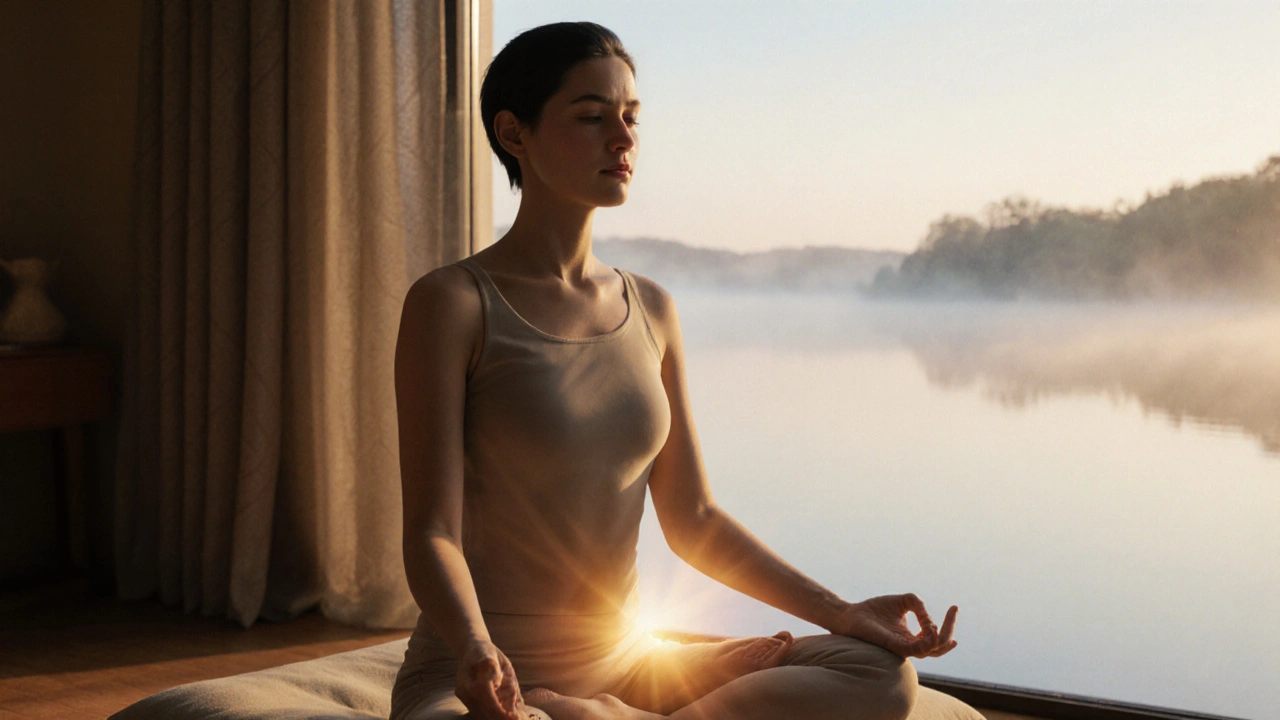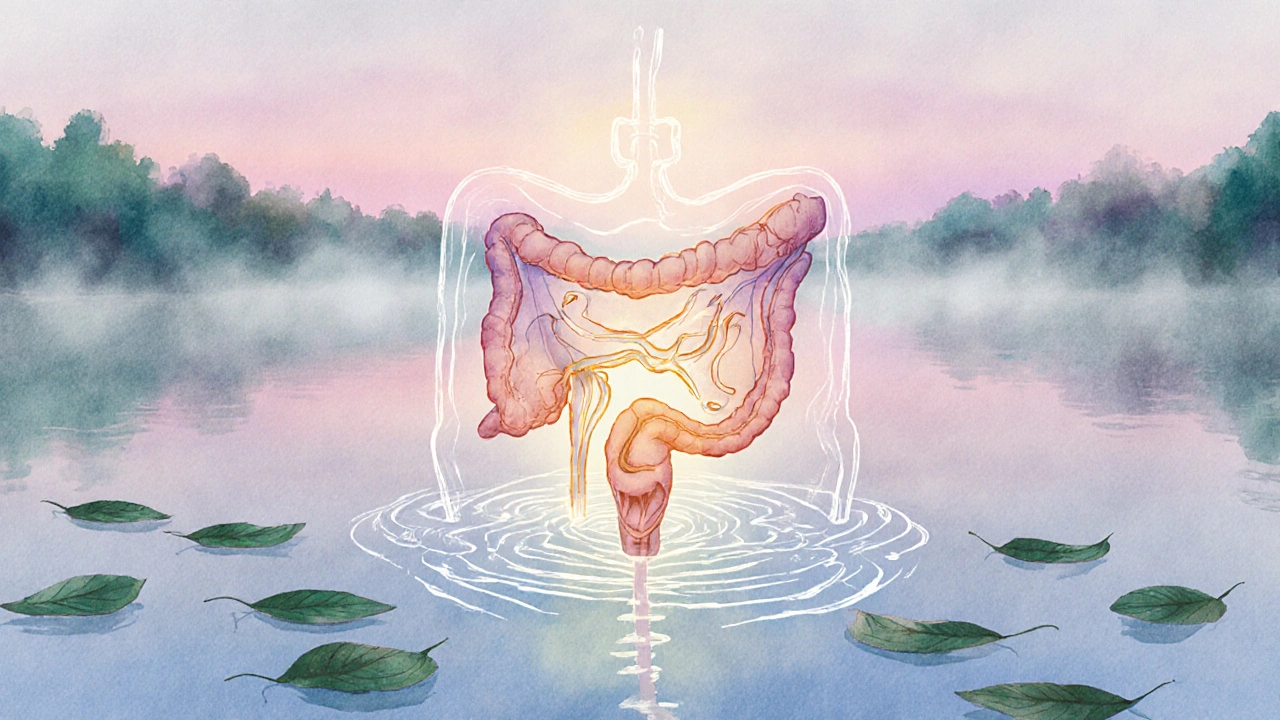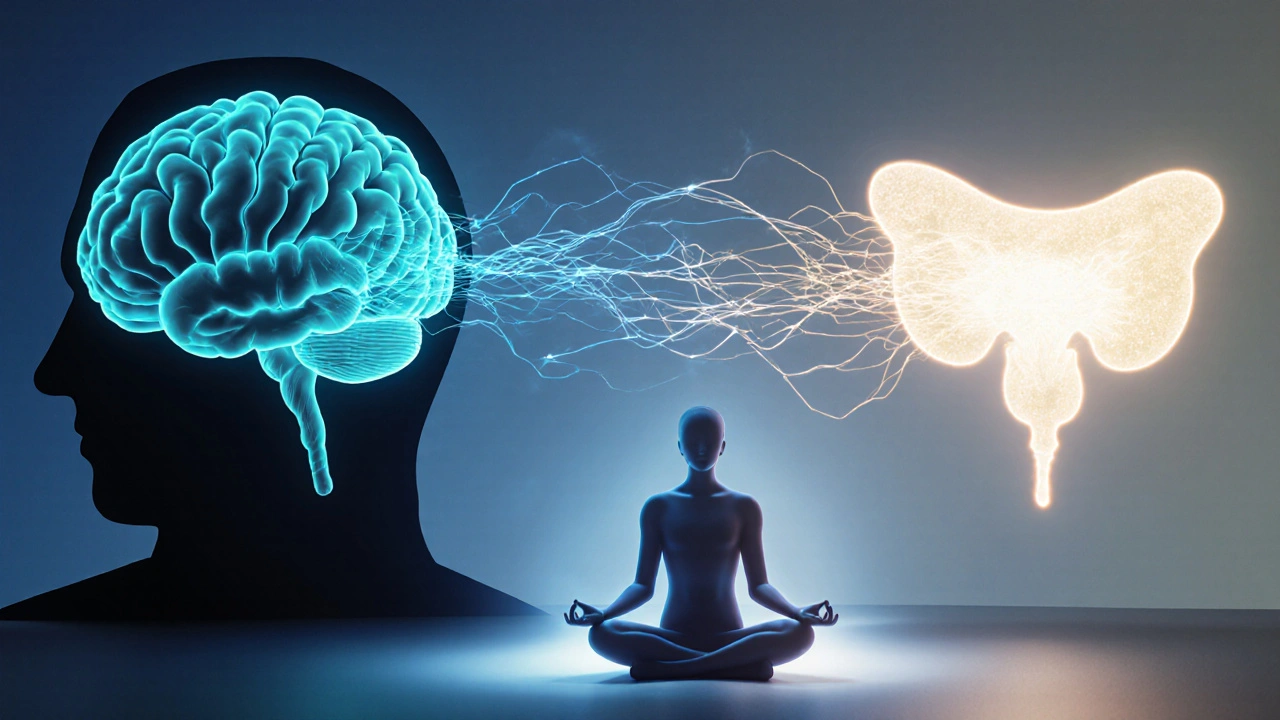Guided Imagery Benefits for Managing Bladder Pain

Bladder Pain Relief Estimator
How Your Practice Could Help
Based on clinical studies, guided imagery can reduce bladder pain by 20-30% with consistent daily practice. This calculator estimates your potential improvement based on your current pain level and practice frequency.
Estimated Pain Reduction
Key Takeaways
- Guided imagery can lower pain intensity and improve quality of life for people with chronic bladder pain.
- The technique works by rewiring pain pathways, reducing stress hormones, and calming the autonomic nervous system.
- Simple 10‑minute sessions, done daily or during flare‑ups, are enough to see measurable benefits.
- Combining guided imagery with physical therapy, diet changes, or medication boosts overall outcomes.
- Consult a healthcare provider if pain worsens or if you have urinary infections that need medical treatment.
What is Guided Imagery?
When you hear the term Guided Imagery is a structured mental‑visualization practice that leads the mind through calming scenes, specific sensations, or therapeutic narratives. It is often delivered via a recorded voice, a therapist’s instructions, or an app. The goal is to create vivid sensory experiences that signal the body to relax.
Understanding Bladder Pain
Bladder Pain refers to chronic discomfort, pressure, or burning in the pelvic region that originates from the bladder wall. Common causes include interstitial cystitis, chronic pelvic pain syndrome, and radiation‑induced cystitis. The pain signals travel through the peripheral nerves to the spinal cord and then to brain regions that interpret discomfort.
Because the bladder is richly supplied by autonomic nerves, any stress‑related spike in sympathetic activity can tighten the detrusor muscle, worsen inflammation, and amplify pain. This feedback loop explains why anxiety or a stressful day often triggers a flare‑up.

Why Guided Imagery Helps - The Science
Three overlapping mechanisms make guided imagery effective for bladder pain:
- Neuroplasticity: Repeated soothing images encourage the brain to form new, less‑painful pathways. Studies using functional MRI show reduced activation in the anterior cingulate cortex after just two weeks of daily imagery practice.
- Stress‑hormone reduction: Visualizing a cool stream or a gentle sunrise lowers cortisol and adrenaline. Lower hormone levels translate to decreased sympathetic tone, which eases bladder muscle spasms.
- Autonomic balance: Guided imagery engages the parasympathetic branch of the Autonomic Nervous System (the network that regulates heart rate, digestion, and bladder function). A calmer nervous system means fewer involuntary contractions that cause pain.
The core benefit of guided imagery for bladder pain lies in its ability to shift the brain’s pain perception while simultaneously calming the bladder’s nervous control.
Getting Started - A Simple 10‑Minute Routine
Below is a step‑by‑step outline you can follow at home or while sitting in a quiet office. No special equipment is required.
- Find a comfortable seated position. Keep your back straight but relaxed.
- Close your eyes and take three slow breaths, inhaling through the nose for a count of four, exhaling through the mouth for a count of six.
- Begin the imagery script: imagine you are standing beside a calm lake. Feel the cool mist on your skin, hear the gentle lapping of water, and notice how the air feels light.
- Shift focus to your pelvic area. Visualize a soft, warm light entering the bladder region, soothing any tightness. Picture the muscle fibers relaxing like leaves floating on the lake surface.
- Stay in this scene for 5-7 minutes, allowing any sensations of pain to melt away. If discomfort reappears, simply acknowledge it and return to the calming lake image.
- Conclude with three deep breaths, slowly opening your eyes. Notice any change in how your bladder feels.
Practice this routine twice daily - once in the morning and once before bedtime - or use it during a flare‑up for immediate relief.
Advanced Tips - Tailoring Imagery to Your Condition
- Use bladder‑specific metaphors: Instead of a lake, picture a gentle garden hose delivering soothing water to a flower (your bladder). This reinforces the idea of gentle flow rather than pressure.
- Incorporate scent cues: Lightly scented lavender or eucalyptus can deepen relaxation because olfactory signals travel directly to the brain’s limbic system.
- Combine with progressive muscle relaxation (PMR): After the imagery, tense and release pelvic floor muscles to reinforce the sense of release.

Comparing Guided Imagery with Other Mind‑Body Options
| Technique | Core Focus | Typical Session Length | Evidence for Bladder Pain |
|---|---|---|---|
| Guided Imagery | Visualization of calming scenes + targeted pelvic imagery | 5‑15min | Moderate - multiple pilot studies show 20‑30% pain reduction |
| Mindfulness Meditation | Non‑judgmental awareness of breath and sensations | 10‑30min | Low - benefits more on stress than direct bladder pain |
| Progressive Muscle Relaxation | Systematic tensing/relaxing of muscle groups | 15‑20min | Low‑moderate - helps pelvic floor tension but less impact on inflammation |
Guided imagery stands out because it merges the mental focus of meditation with a specific visual cue for the bladder, making it more directly relevant to pelvic pain.
Common Pitfalls & How to Avoid Them
- Rushing the visualization: Skipping the breathing prep reduces the brain’s ability to enter a relaxed state. Stick to the full 3‑breath opening.
- Using disturbing images: If a scene feels unsettling, replace it with something personally soothing - a childhood memory, a favorite hobby, or a pet.
- Expecting instant cure: Benefits accumulate over weeks. Track pain scores in a journal to see gradual improvement.
- Neglecting medical care: Guided imagery complements, not replaces, prescribed treatments. Keep your urologist informed.
When to Seek Professional Guidance
If you notice any of the following, schedule an appointment with a Healthcare Provider (a physician, nurse practitioner, or pelvic‑floor therapist):
- Sudden increase in pain intensity or new urinary symptoms (blood, fever, burning).
- Pain that does not improve after four weeks of consistent guided imagery practice.
- Emotional distress, anxiety, or depression that interferes with daily life.
A multidisciplinary approach-combining medication, diet, physical therapy, and guided imagery-offers the best chance at long‑term relief.
Frequently Asked Questions
Can I use guided imagery if I have a urinary tract infection?
Guided imagery can help reduce stress during an infection, but it won’t treat the bacteria. Continue antibiotics as prescribed and use imagery as a supportive tool.
How often should I practice?
Two sessions a day-once in the morning and once before sleep-are ideal. During a flare‑up, you can add a quick 5‑minute session whenever you feel the pain spike.
Do I need special audio recordings?
Not at all. A simple script you create yourself works fine. Many free apps also offer bladder‑focused guided imagery tracks.
Is guided imagery safe for children with bladder pain?
Yes, as long as the imagery uses age‑appropriate scenes (e.g., a friendly cartoon garden) and the child is supervised by a caregiver.
Can guided imagery replace medication?
It can lower the dose needed for some patients, but it usually works best as an adjunct, not a stand‑alone treatment.
It's not a coincidence that guided imagery is being hyped right when the pharmaceutical lobby is fighting to keep opioids on the market 😒. The hidden agenda is all about keeping us dependent on pills while offering a "natural" alternative that they can't patent. If you dig a little deeper you'll see the same think‑tanks that lobby for drug legislation also fund mindfulness research. The truth is that our own minds are the most powerful medicine, and the powers that be prefer us to stay blind 🧠. So keep an eye on who profits from every new wellness trend.
One must recognize that the superficial allure of "visualization" is nothing more than a passing fad for the easily swayed masses. The real art of healing demands discipline, rigour, and a rejection of commercialized fluff. If you cannot commit to a strict regimen, then you deserve the lingering discomfort that follows. Its simply a matter of willpower, not some mystical trick. People who chase after every trendy practice are merely feeding the profit engines of the uninformed. This is how we descend into cultural decay.
I've seen many patients experience a measurable drop in pain scores after integrating a brief guided imagery routine into their daily schedule. The key is consistency: a ten‑minute session each morning and evening can rewire the pain pathways over time. Pairing the visualization with gentle pelvic floor stretches further enhances the effect, as the nervous system receives complementary signals of relaxation. Keep a simple log of your pain levels; the trends will become evident within a few weeks. Remember, the practice is an adjunct, not a replacement for your prescribed therapy.
It is absurd to claim that a ten minute daydream can outshine a clinical trial . The evidence is thin at best and the studies are riddled with bias . One must question why the medical community jumps on the bandwagon without rigorous double blind data . The narrative fits a market eager for low cost solutions . Yet the human body is complex and cannot be pacified by pictures alone .
Listen up, folks, you don't have to choose between medication and mindfulness-combine them and dominate your pain. The community thrives when we share proven strategies, so I urge you to post your favorite guided scripts and results. Don't let anyone tell you that a simple visualization is "just a fad"; when applied aggressively it can knock down flare‑ups like a champion. Let's build an inclusive hub where every voice adds strength to the collective fight against bladder pain.
Hey gang! 🌟 I'm really happy to see so many people giving guided imagery a try. It can feel magical when you notice that soothing lake scene melting away tension. Keep at it two times a day and watch the pain dip gradually. Remember to celebrate tiny wins, like a night with less urgency. Your progress is real and you deserve every bit of relief! 😊
Guided imagery, when approached with both curiosity and discipline, can become a cornerstone in the multimodal management of chronic bladder pain. The practice begins with a simple breath, a foundational step that signals the nervous system to transition from a sympathetic to a parasympathetic state, thereby creating the physiological window for effective visualization. Each inhalation draws in calm, each exhalation releases tension, and this rhythmic exchange sets the stage for the mind to conjure therapeutic scenes. By directing attention to a tranquil lake, for example, the practitioner taps into the brain's default mode network, which is known to modulate pain perception. Over time, repeated sessions encourage neuroplastic changes, gradually dimming the hyperactive pain circuits that have been sensitized by chronic inflammation. This rewiring is not instantaneous; it unfolds over weeks, sometimes months, as the brain learns new, less threatening interpretations of pelvic sensations. The technique also leverages the body's innate ability to regulate autonomic output, reducing the release of cortisol and catecholamines that exacerbate bladder spasms. When cortisol levels fall, the inflammatory cascade decelerates, granting the bladder a reprieve from the perpetual cycle of pain and stress. Moreover, guided imagery can be seamlessly integrated with other modalities, such as pelvic floor physical therapy, creating a synergistic effect that amplifies overall outcomes. For patients who struggle with medication side effects, this non‑pharmacologic avenue offers a gentle yet potent alternative that respects the body's natural healing capacities. It also empowers individuals, giving them an active role in their symptom management rather than positioning them as passive recipients of treatment. Consistency remains the linchpin; a brief daily ritual is far more impactful than sporadic, lengthy sessions. Tracking progress in a simple journal helps to affirm subtle improvements that might otherwise go unnoticed. Importantly, the practice should be personalized-some may find a garden scene more soothing than a lake, while others might benefit from focusing on warm light permeating the pelvic region. The flexibility of guided imagery ensures it can be adapted to cultural preferences and personal narratives. Finally, while the method is safe for most, it is essential to maintain open communication with healthcare providers to ensure that any changes in pain patterns are appropriately evaluated. In sum, guided imagery offers a multifaceted, evidence‑backed tool that, when employed diligently, can substantially alleviate chronic bladder discomfort and improve quality of life.
Yo dude, i gotta say your post really hit home i’ve been juggling muscle tensing and mental pics for ages lol. i think the key is to blend the visual with a bit of music it just vibes better. also dont be scared to talk about ur feelings with a doc they wont bite. keep experimenting and let the mind wander, it's all about that chill flow.
Our people deserve pain‑free lives, start using guided imagery now.
I’ve tried the lake visualization and noticed a subtle drop in urgency after a week, definitely worth the effort.
Yo, this guided imagery sh*t is the real MVP for bladder pain – it hacks the neuro‑feedback loop and cuts the nociceptive fire, no cap.
Interesting take on the autonomic balance aspect 😊. The connection between parasympathetic activation and reduced bladder spasm seems solid. I’ll keep an eye on upcoming studies for more data.
Brandon, your deep dive really captures the layered benefits of guided imagery, and I appreciate the emphasis on neuroplasticity and the symbiotic relationship with pelvic floor therapy. The practical tip about journaling resonates strongly; documenting subtle shifts can keep motivation high. Your balanced perspective reminds us that while the technique isn’t a miracle cure, it is a powerful adjunct in a comprehensive pain‑management plan.